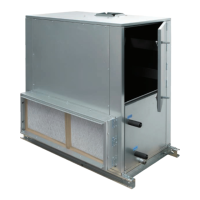ENVIRO-TEC
15
FORM ET115.24-NOM12 (718)
Figure 6a-6b: Electric heater assembly
COIL
The entering air side of the coil may be cleaned in place
by removing the lters from the unit, accessing from
the inlet, and then brushing the coil face between ns
with a soft brush parallel to ns. To clean the leaving
air side of the coil, gain entry through the access door
and then follow the same brushing procedure. Do not
brush perpendicular to n orientation as damage may
occur. Brushing should be followed by cleaning with a
vacuum cleaner. If a compressed air source is available,
the coil may also be cleaned by blowing air through the
coil ns from the leaving air face. Vacuuming should
again follow this. Units provided with proper type of air
lters, replaced regularly, may require periodic coil cleaning.
ELECTRIC RESISTANCE HEATER ASSEMBLY
Electric resistance heaters typically require no normal
periodic maintenance when unit air lters are changed
properly. Other conditions and equipment may affect the
operation and service life in the system. The two most
important operating conditions for an electric heater are
proper airow and proper supply voltage. High supply
voltage and/or poorly distributed or insufcient airow
over the element will result in element overheating. This
condition may result in the heater cycling on the high
limit thermal cutout. Open wire type heaters provided
have an automatic reset switch with a back-up high
limit thermal switch. Automatic reset switches are as
the name implies; they reset automatically after the
heater has cooled down. The high limit thermal cutout
device is a manual reset safety device. With proper
unit application and during normal operation, the high
limit thermal cutout will not operate. This device only
operates when some problem exists. ANY condition
that causes high limit cutout MUST be corrected
immediately. Once the high limit trips, it may be reset
once the unit has cooled down. Refer to troubleshooting
section for high limit reset instructions. High supply
voltage also causes excessive amperage draw and may
result in tripping of the circuit breaker or blowing of
the fuses on the incoming power supply.
Figure 6a
Figure 6b

